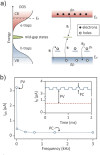Photogating in Low Dimensional Photodetectors
- PMID: 29270342
- PMCID: PMC5737233
- DOI: 10.1002/advs.201700323
Photogating in Low Dimensional Photodetectors
Abstract
Low dimensional materials including quantum dots, nanowires, 2D materials, and so forth have attracted increasing research interests for electronic and optoelectronic devices in recent years. Photogating, which is usually observed in photodetectors based on low dimensional materials and their hybrid structures, is demonstrated to play an important role. Photogating is considered as a way of conductance modulation through photoinduced gate voltage instead of simply and totally attributing it to trap states. This review first focuses on the gain of photogating and reveals the distinction from conventional photoconductive effect. The trap- and hybrid-induced photogating including their origins, formations, and characteristics are subsequently discussed. Then, the recent progress on trap- and hybrid-induced photogating in low dimensional photodetectors is elaborated. Though a high gain bandwidth product as high as 109 Hz is reported in several cases, a trade-off between gain and bandwidth has to be made for this type of photogating. The general photogating is put forward according to another three reported studies very recently. General photogating may enable simultaneous high gain and high bandwidth, paving the way to explore novel high-performance photodetectors.
Keywords: infrared; low dimensional; photodetectors; photogating; phototransistors.
Figures











References
-
- Hawkins A. R., Wu W., Abraham P., Streubel K., Bowers J. E., Appl. Phys. Lett. 1997, 70, 303.
-
- Kang Y., Liu H.‐D., Morse M., Paniccia M. J., Zadka M., Litski S., Sarid G., Pauchard A., Kuo Y.‐H., Chen H.‐W., Zaoui W. S., Bowers J. E., Beling A., McIntosh D. C., Zheng X., Campbell J. C., Nat. Photonics 2008, 3, 59.
-
- Gao Y., Cansizoglu H., Polat K. G., Ghandiparsi S., Kaya A., Mamtaz H. H., Mayet A. S., Wang Y. A., Zhang X. Z., Yamada T., Devine E. P., Elrefaie A. F., Wang S. Y., Islam M. S., Nat. Photonics 2017, 11, 301.
-
- Rogalski A., Infrared Phys. Technol. 2002, 43, 187.
-
- Kinch M. A., Borrello S. R., Infrared Phys. 1975, 15, 111.
Publication types
LinkOut - more resources
Full Text Sources
Other Literature Sources
